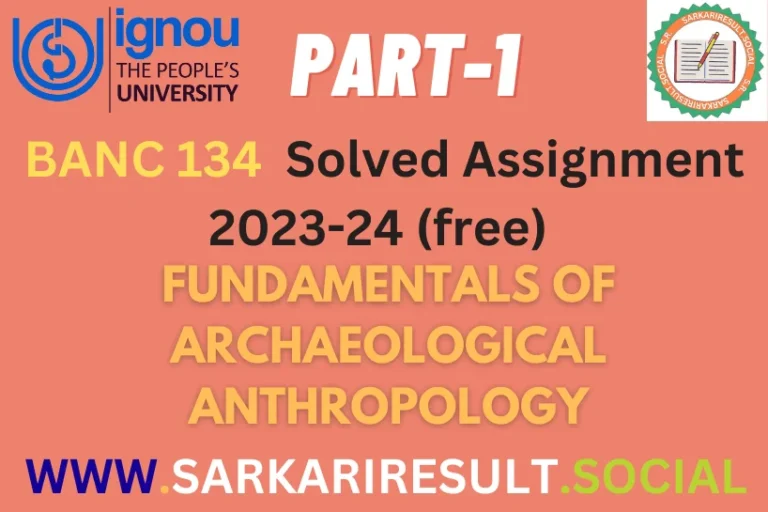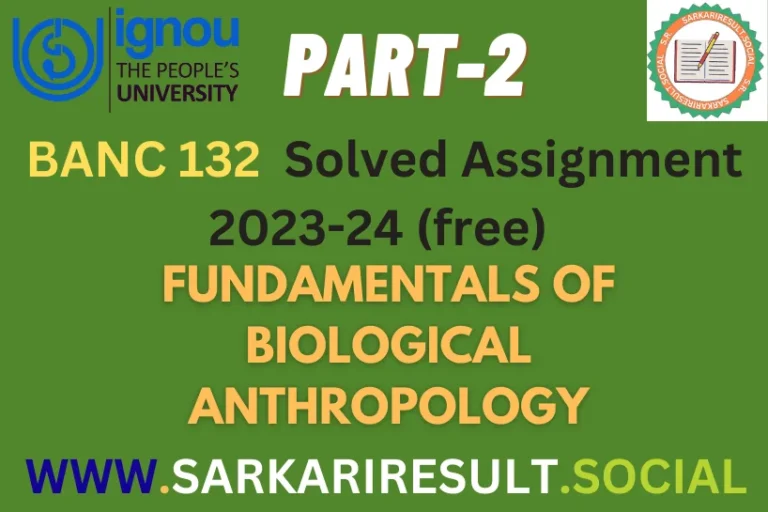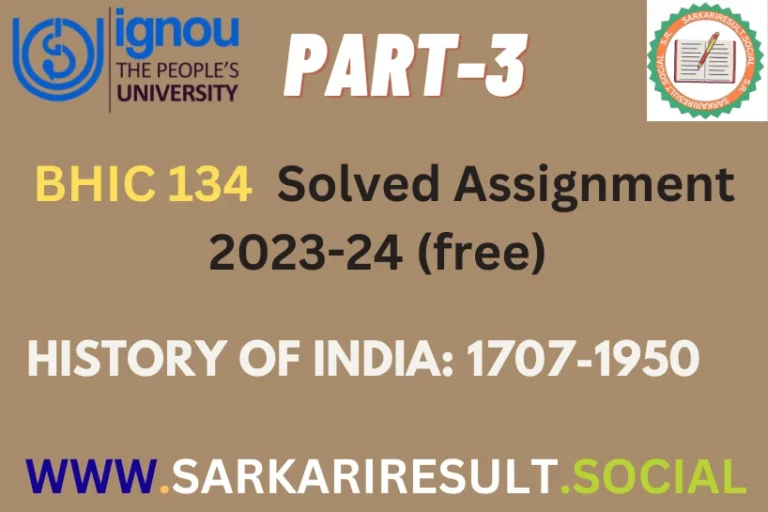BHIC 131 IGNOU Solved Assignment 2023-24 (free) Part -1

BHIC 131 IGNOU Solved Assignment 2023-24 (free) Part -1
Unlock historical insights with our BHIC 131 IGNOU Solved Assignment 2023-24 (free) Part -1! Crafted to elevate your understanding and critical analysis, these solutions ensure adherence to guidelines and word limits. Score high and excel in your term-end examinations. Enhance your historical knowledge today—get your BHIC-131 IGNOU solved assignment now!

1) Explain archaeological excavation. Discuss some prominent archaeological sites in the Indian subcontinent.
Ans. Archaeological excavation is a systematic process employed by archaeologists to unearth and study material remains buried beneath the Earth’s surface. It involves carefully removing layers of soil and debris to reveal artifacts, structures, and features that provide insights into past human civilizations and activities. Here’s an overview of the excavation process and some prominent archaeological sites in the Indian subcontinent.
Also Read This: BANC-131 IGNOU Solved Assignment 2023-24 (free) Part 1
Archaeological Excavation Process:
1. Survey and Site Selection: Archaeologists conduct surveys to identify potential sites using methods like aerial photography, satellite imagery, and ground surveys. Once a site of interest is identified, detailed investigations begin.
2. Site Preparation: Before excavation, the site is meticulously mapped and surveyed to establish the initial layout and determine the areas for excavation. Archaeologists create a grid system for precise documentation.
Also Read This: BANC-131 IGNOU Solved Assignment 2023-24 (free) Part 2
3. Excavation Strategy: Archaeologists employ different excavation methods based on the site’s characteristics and research goals. These methods include trenching, test pits, vertical digging, and horizontal exposure to uncover artifacts and structures layer by layer.
4. Stratigraphy and Context Recording: Layers of soil or sediment (strata) are excavated carefully, with each layer representing a different time period. Recording the position and context of artifacts within these layers is crucial for interpreting their significance.
Also Read This: BANC-131 IGNOU Solved Assignment 2023-24 (free) Part 3
5. Artifact Recovery: Recovered artifacts, such as pottery, tools, bones, and architectural remains, are meticulously cleaned, cataloged, and analyzed. Special care is taken to preserve delicate items.
6. Documentation and Analysis: Detailed records, including notes, sketches, photographs, and measurements, are made throughout the excavation. These records aid in reconstructing the site and interpreting its cultural significance.
7. Dating Methods: Various dating techniques, such as radiocarbon dating, stratigraphy, and thermoluminescence, are employed to determine the age of the artifacts and the site.
Also Read This: Check BGDG 172 IGNOU solved assignment 2023-24 (Free)
Prominent Archaeological Sites in the Indian Subcontinent:
1. Mohenjo-daro and Harappa: These sites are part of the Indus Valley Civilization, one of the world’s earliest urban civilizations. Mohenjo-daro, in present-day Pakistan, and Harappa, in Pakistan’s Punjab province, feature advanced urban planning, drainage systems, and well-organized cities dating back to around 2600-1900 BCE.
2. Lothal: Located in Gujarat, India, Lothal is a Harappan site known for its advanced dockyard, indicating trade and maritime activities. It exhibits evidence of a sophisticated urban center engaged in seafaring and trade during the Bronze Age.
3. Sanchi Stupa: Situated in Madhya Pradesh, India, Sanchi is famous for its Buddhist stupas and monasteries dating back to the Mauryan period (3rd century BCE). The Great Stupa at Sanchi is a UNESCO World Heritage Site, adorned with intricate carvings and sculptures depicting Buddhist stories and teachings.
Also Read This: Check BSOG 173 IGNOU solved assignment 2023-24 (Free)
4. Ajanta and Ellora Caves: Located in Maharashtra, India, these cave complexes contain rock-cut Buddhist, Hindu, and Jain temples and monasteries dating from the 2nd century BCE to the 10th century CE. The caves feature exquisite sculptures, paintings, and architectural marvels.
5. Kalibangan: Situated in Rajasthan, India, Kalibangan is a Harappan site known for its unique fire altars, terracotta figurines, and well-planned streets, providing insights into Harappan urban life and craftsmanship.
6. Hampi: In Karnataka, India, Hampi was the capital of the Vijayanagara Empire. The site contains extensive ruins of palaces, temples, and markets, showcasing impressive architectural and artistic achievements from the 14th to 16th centuries.
These archaeological sites in the Indian subcontinent represent diverse cultural, religious, and architectural achievements, offering invaluable insights into ancient civilizations, urban planning, trade networks, art, and societal structures. Excavations at these sites continue to contribute significantly to our understanding of the region’s rich cultural heritage and historical evolution.
Also Read This: Check top Begae 182 IGNOU solved assignment 2023-24 (Free)
2) Analyze the process of formation of some regions in ancient India.
Ans. Ancient India was a region of rich cultural diversity, shaped by various geographical, climatic, social, and historical processes that led to the formation of distinct regions. The formation of these regions was influenced by factors such as river systems, topography, climate, migrations, trade routes, and cultural interactions. Here’s an analysis of the process of formation of some key regions in ancient India:
1. Indus Valley Region:
The Indus Valley Civilization (c. 2600–1900 BCE) flourished along the banks of the Indus River and its tributaries in present-day Pakistan and northwest India. The fertile plains of the Indus River facilitated agricultural development and urbanization. Cities like Mohenjo-daro and Harappa were centers of trade, craftsmanship, and social organization. The region’s well-planned cities, advanced drainage systems, and trade connections contributed to its distinct identity.
Also Read This: Discover BPAG 174 ignou solved Assignment (Free) 2023-24
2. Ganges Plain:
The Ganges (Ganga) River and its tributaries, notably the Yamuna, formed the Ganges Plain, an agriculturally rich region in northern India. The fertile alluvial soil supported agriculture, leading to the emergence of early settlements and cities. The region’s religious significance, cultural diversity, and historical prominence, including the rise of kingdoms like Magadha, contributed to its distinctiveness.
3. Deccan Plateau:
The Deccan Plateau, comprising central and southern India, was characterized by its varied topography, including plateaus, hills, and fertile river valleys. Its landscape influenced the formation of regional kingdoms and cultures. The region’s history witnessed the rise of dynasties like the Satavahanas, Chalukyas, and Rashtrakutas, each contributing to the cultural and architectural heritage of the area.
Also Read This: MPCE 012 IGNOU Solved Assignment 2023-24 (free) Part 1
4. Himalayan Region:
The Himalayan region, with its diverse topography, high mountain ranges, and river valleys, shaped unique cultural and ecological landscapes. The region provided natural boundaries and served as a protective barrier, influencing cultural interactions and trade routes between India and Central Asia. It also contributed to the emergence of distinctive cultural practices and traditions in the Himalayan foothills and valleys.
5. Coastal Regions:
The coastal regions along the Arabian Sea and the Bay of Bengal were hubs of maritime trade, attracting interactions with foreign traders and civilizations. Coastal cities like Kaveripattinam, Bharuch, and Tamralipta engaged in commerce, fostering cultural exchanges and the spread of ideas, religions, and artistic styles.
Also Read This: MPCE 012 IGNOU Solved Assignment 2023-24 (free) Part 2
Formation Processes:
1. Geographical Factors: River systems, fertile plains, mountains, and coastlines played pivotal roles in defining and shaping these regions by influencing settlement patterns, agricultural practices, and trade networks.
2. Cultural Interactions: Interactions between indigenous populations, migrations, trade, and the spread of religions and ideologies led to the amalgamation of diverse cultural elements, creating unique regional identities.
3. Political Developments: The rise and fall of kingdoms, dynasties, and empires contributed to the political, social, and cultural landscapes of these regions.
4. Economic Factors: Trade routes, agricultural productivity, and resource availability influenced economic activities and societal organization, further shaping regional identities.
Also Read This: MPCE 012 IGNOU Solved Assignment 2023-24 (free) Part 3
In conclusion, the formation of regions in ancient India was a complex interplay of geographical, cultural, economic, and historical processes. These regions developed distinct identities characterized by diverse cultural practices, architectural styles, trade networks, and socio-political structures, contributing to the rich tapestry of ancient Indian civilization.







